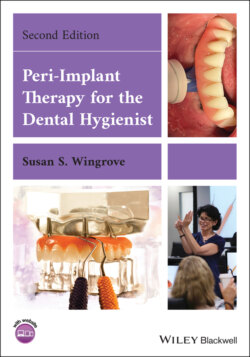Читать книгу Peri-Implant Therapy for the Dental Hygienist - Susan S. Wingrove - Страница 28
Cardiovascular/cerebrovascular (CV/CV) disease
ОглавлениеThere is a documented association between inflammation, periodontal/peri‐implant disease, infection, and the risk of cardiovascular/cerebrovascular (CV/CV) disease. The national survey of health conditions of the US population collected between 1988 and 1994 (NHANES III database) states; “the relationship between periodontal attachment loss and the risk of myocardial infarction was demonstrated.” This data suggest a real and important influence of periodontitis on the risk of CV/CV disease. According to the American Academy of Periodontology (AAP) Mouth Body Connection, “Researchers have found that people, especially diabetics with periodontal disease are almost twice as likely to suffer from coronary artery disease” (4).
As dental professionals, we can provide treatment for periodontitis/implantitis that may help prevent the onset of and delay in the progression of CV/CV disease. Oral bacteria/biofilm can affect the heart by attaching to fatty plaques in the arteries and forming clots. These clots can cause obstructions that can lead to a heart attack. Infection and/or inflammation responses can also affect the buildup of biofilm on the inner lining of the blood vessels supplying the heart (coronary arteries) or brain (carotid arteries) that occurs in atherosclerosis (4, 5).
A growing number of research studies also support the contribution of periodontal/peri‐implant infection to the inflammatory burden theorized to be both a direct action on blood vessel walls and by indirectly inducing the liver to produce cardiac reactive proteins (CRPs) through an acute‐phase response (13). CRPs are produced by the liver in response to infection and inflammation, and are a specific systemic marker of vascular inflammation that appears to have a strong association with adverse vascular events; see Figure 2.1 (14).
CRPs are also referred to as hepatic plasma proteins or C‐reactive proteins. They are found in trace amounts even in healthy people, however, if elevated levels of these proteins are found it can signify serious inflammation in the body. CRP levels can go as high as 400–500 mg/L in seriously ill patients (see Table 2.1). Many different diseases and conditions can elevate CRP levels such as; periodontal disease, cardiovascular disease (CVD), trauma, surgery, burns, advanced malignancy, Alzheimer’s disease, blood sugar disorders, smoking, and obesity.
Table 2.1 Levels of cardiac reactive proteins (CRPs).
| Normal CRP | <1.0 mg/L |
|---|---|
| Intermediate CRP | 1.0–2.9 mg/L |
| High CRP | >3.0 mg/L |
Alzheimer’s disease is being viewed as an inflammatory brain disorder due to studies that have shown that patients with high levels of CRPs were three times more likely to develop Alzheimer’s disease. Tobacco also raises CRP levels and has a residual effect that remains in the body for years. Smoking causes oxidants to form and might accelerate the oxidation of low‐density lipoproteins (LDLs) constituents, which causes arterial inflammation even in healthy individuals with normal LDL levels.
To detect and monitor inflammation, the CRP blood test is becoming a leading marker for systemic inflammation in the body. Intermediate to high levels of CRPs found in this specific blood test indicate an increase in inflammation somewhere in the body, are cause for concern, and the inflammation needs to be identified.
CRP testing is a significant tool for identification of patients at risk for CV/CV, CVD, and prevention of CVD (15). Dental professionals are currently using high‐sensitivity C‐reactive protein (hs‐CRP) testing in dental practices chair‐side. They are requesting the test from the patient’s physician to identify and monitor patients at risk for acute coronary syndromes or periodontal/peri‐implant disease.
Severe periodontal/peri‐implant disease patients have more harmful bacteria in their bloodstreams than patients with moderate or no disease (Figure 2.1). The inflammatory process of periodontal/peri‐implant disease increases CRP levels and when periodontal disease or peri‐implant disease are treated, the CRP levels decrease and the hemoglobin A1c (HbA1c) levels improve (16, 17). HbA1c level is also an important marker in monitoring diabetes. Both CRP and LDL cholesterol level tests are minimally correlated, but CRP has been found in some studies to be a stronger predictor of future cardiovascular events than LDL cholesterol (14).
The bottom line is that CRPs are going to be an important link for dentistry. Inflammation is turning out to be the missing link for diagnosing and treating many systemic diseases. The key for dentistry is that periodontal disease and now peri‐implant disease is one of the most prominent inflammatory diseases in the body. In medical journals, the recommendation is that the first stop for a patient with increased CRP levels is a screening by a dentist or specialist for periodontal/peri‐implant disease or other oral infections. If the CRP levels remain elevated over 3.0 mg/L, a referral to the primary care physician is recommended for evaluation for systemic diseases. Educate your patients about pre‐procedural health before treatment for optimal successful long‐lasting results.
